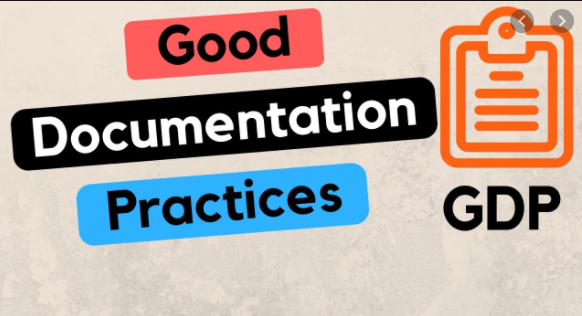What are good documentation practices & how can they best be implemented?
Good documentation practice (commonly abbreviated GDP, recommended to abbreviate as GDocP to distinguish from “good distribution practice” also abbreviated GDP) is a term in the pharmaceutical and medical device industries to describe standards by which documents are created and maintained. While some GDP / GDocP standards are codified by various competent authorities, others are not but are considered cGMP (with emphasis on the “c”, or “current”).
Objective of Documentations
• Defines specifications and procedures for all materials and methods of manufacture and control
• Ensures all personnel know what to do and when to do it
• Ensure that authorized persons have all information necessary for release of product
• Ensures documented evidence, traceability, provide records and audit trail for investigation
• Ensures availability of data for validation, review and statistical analysis.
It has been said that in the pharmaceutical industry, “If it isn’t documented, it didn’t happen” Therefore, in the pharmaceutical and medical device industry, we document to provide written proof that something happened.
For this reason good documentation practices—commonly referred to as GDPs–are critical.
Records and reports related to production events represent the only official, documented record of:
• Processing a batch
• Producing a device
• The final decision to release (or reject) a batch or product
• The evidence for a corrective or preventive action (CAPA)
• An investigation of manufacturing deviations, complaints or alleged product defects
• Meeting product and quality specifications generated from test results ,Records and reports, along with procedures, “tell the story” of manufactured products and devices.
In addition to regulatory requirements, it is also very important to maintain accurate records for business reasons.
By maintaining clear, accurate and timely records you can take a critical look at various processes related to product manufacture with the intent of making quality, product or cost saving improvements.
GDPs apply to everyone who documents activities related to cGMP or current Good Manufacturing Practices.
Compliance with the Food and Drug Administration’s GLP, or Good Laboratory Practices, regulations (21 CFR Part 58), as well as GMP regulations for drugs and medical devices (21 CFR Parts 211 and 820) requires the use of Good Documentation Practices.
GDPs are enforced by regulatory agencies such as the FDA, TGA, EMEA, Health Canada or WHO.
What Are Good Documentation Practices?
Good Documentation Practices, commonly referred to as GDPs, are the guidelines that one follows in recording raw data entries in a legible, traceable and reproducible manner.
A key to Good Documentation Practices is to consider these questions each time you record your raw data:
1. Is it true?
2. Is it accurate?
3. Is it timely?
4. Is it legible?
What types of documents require following Good Documentation Practices?
Some examples include:
• Analytical Methods
• Batch Records
• Bills of Materials (BOMs)
• Certificate of Analyses (CoA)
• Certificate of Compliance (CoC)
• Laboratory Notebooks
• Logbooks
• Policies
• Protocols
• Quality records – (Non-conformances, CAPAs, internal inspection reports and change control)
• Standard Operating Procedures
• Test Methods
• Training Documentation
• Validation Documents (IQs, OQs and PQs)
• Work Instructions
• Product and Sample Labels
Categories of Documents
1. Primary records such as those obtained from the master formula, manufacturing and packaging instructions.
2. Supporting procedures such as instructions on how to perform a manufacturing step or test methodology.
3. Subsidiary records which support the process as it is being carried out, such as environmental monitoring or preventive maintenance/calibration on process or lab equipment.
4. Quality control records include all lab testing results for the process or products and al investigative reports and records.
Type of documents used in pharmaceuticals
• Specifications: as per MHRA Specifications describe in detail the requirements with which the products or materials used or obtained during manufacture have to conform. They serve as a basis for quality evaluation. We need specification for:
1. Active and Excipients
2. Primary ,Secondary and Tertiary packing materials
3. Intermediate and semi finished product
4. Finished product
• SOPs: it is a written, standard procedure for the preparation, approval, authorization and control of Standard Operating Procedures.
• Test method: it is a written and approved documents describe the step by step testing procedure.
• List: Documents contain a detail list of documents/any material/other things such as list of equipments.
• Certificates of Analysis: n authenticated document that is issued by Illumina’s Quality Assurance Department that ascertains that a product has met its predetermined product release specification(s) and quality.
• Label
• Records
• Organ gram
• Job description
• Batch Manufacturing records: it is an important document issued for every batch of product to assure, review and record keeping of any product batch. There are following major content of BMR.
1. Name of product, generic name, strength, shelf life ,manufacturing date and exp date.
2. A complete list of ingredients with full description, codes and quantity to be issued.
3. A statement for theoretical yield and reconciliation.
4. A complete MFG and control instructions, sampling and testing procedure, specification and precaution to be followed.
5. A statement for processing location and equipment.
6. The method or reference to method to be used for preparing the critical equipment including cleaning, assembling, calibrating and sterilizing.
7. Dates and time of all activities
8. Line clearance procedure in every steps
9. Labeling control and specimen for coding in primary, secondary and tertiary packing materials
10. Deviation record
11. Result of examine made.
The Meaning of Signature
Generally speaking, when signing your name to a GMP document, you:
1. Confirm your unique identity.
2. State that you have the authorization to perform, verify, check, review or approve the activity associated with your name.
3. Recognize that your signature and initials cannot be taken back; once signed,you are personally, professionally and legally responsible for the action taken.
Controlling Your Signature
It is imperative that you maintain strict control over the use of your signature and initials. Sign and initial only for yourself. Never allow someone else to sign or initial for you unless that person is authorized in writing to do so and according to procedure.
Signature Log or Signature Logbook
Everyone who signs controlled documentation must register their signature and initials.
This allows identification of a person performing or supervising a specific GMP activity.
This registration includes all temporary and contract employees.
The current Good Manufacturing Practices state: “Batch production and control records shall be prepared for each batch of drug product produced and shall include complete information relating to production and control of each batch.
These records shall include: identification of the persons performing and directly supervising or checking each significant step in the operation.” 21CFR211.188 We should always be able to see who is responsible for performing a specific operation or entering data.
We cannot just use names because names are not unique—several people may have the same name. And, it is difficult to use signatures all of the time because they are often illegible. As a result, we use initials; and it is these signatures and initials that must be registered.
Remember, you must always sign or initial documents exactly as you have entered your signature and initials in the signature log book.
Note: Don’t forget to update your signature and initials if your name changes.
References: GMP training.com and WHO Guideline


